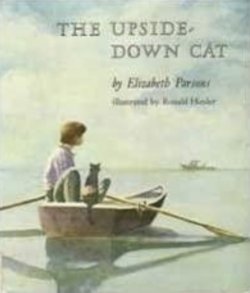Gareth B. Matthews

Review of The Upside-Down Cat by Elizabeth Parsons (New York: Atheneum, 1981). Originally published in Thinking: The Journal of Philosophy for Children 4(1): 1.
Lily Black was a black-and-white cat who spent most of her year with Joe and his parents in the middle of New York City and then summered with them in Maine. She got called the “Upside-Down Cat” from her odd habit of lying on her back over a hot-air register, to keep warm.
At the end of one summer, just before Joe and his family set out for the return trip to New York, Lily Black disappeared. Devastated, the family returned without her. Lily Black, meantime, was being looked after by a kind lobsterman, who kept her at his fish house. Through the long, cold winter the old fisher man became as fond of his “Miss Kitty” as Joe and his parents had been before.
Shortly after the New York family returned to Maine the next summer, Joe spotted Lily Black in the old man’s lobster boat. Joe claimed her immediately and took her away from the lobsterman. But his conscience soon gave him trouble. He began to make friends with the lobsterman and eventually brought himself to say, with great effort, “Well, she’s your cat too, sort of . . . You saved her life, why shouldn’t she be yours?” The old man obligingly renounced his claim to Lily Black. He also rejected, in kindness, a proposal that they share the cat. ” I’d like to see her out here with you once in a while, “he said, simply· “that’s all. ”
Did the old man give up his right to Lily Black? He did, if he had a right to her in the first place. Did he have a right to her? Or any sort of claim on her at all?
We think of pets as property. If they are property, how do we gain and lose our rights to them? More troublingly, should they be thought of as property at all?
In Great Britain swans cannot be the property of an ordinary citizen; they belong to the Queen. Are there some living creatures that can’t be anyone’s property, not even the Queen’s?
Not long ago most Blacks in this country were considered property; they were taken to be the property of slave “owners.” Even earlier, wives and children were taken to be the property of their husbands and fathers. Will the kinds of living being that can count as property shrink even further in the future?
We are now beginning to worry about the rights of the nonhuman primates who have been taught American sign language. When the zoo that “owns” Koko, the gorilla, sought to reclaim her from her psychologist companion, a lawyer volunteered to defend Koko’s civil rights. And recently, when two “articulate” chimps, Nim Chimsky and his brother, Ally, were sent to a laboratory to be used as test animals for a hepatitis virus, there was a great outcry. (New York Times, June 10, 1982, A26) One argument offered for freeing these animals and placing them in a “retirement home” was that they had expressed, in sign language, the wish to’ get “out.”
Genuine speech is widely considered to be a sufficient, though not a necessary, condition for being a person. it is, of course, controversial whether even the most adept signers among the chimps and gorillas who have been taught sign language have genuine speech. If they do, they are, by this test, persons, and not property. But, of course, many human beings-infants, for example, and certain stroke victims are persons without having speech. Should we count some speechless nonhuman beings as persons? And even if a given animal is not a person, might it still be ineligible for counting as property?
Perhaps the conflict between Joe and the old lobsterman is not well conceived as one of property rights, but one of guardianship. Who has a right to be Lily Black’s guardian? Who would make the better guardian? Perhaps pet ”owners” in general should be thought of as pet “guardians.” To be sure, guardians have rights; but so do the creatures whose interests they have agreed to protect.
None of these issues is raised explicitly in The Upside-Down Cat. But the story is told so sensitively that reflective readers are nudged towards raising them for themselves. Once raised, the questions will not go away.
